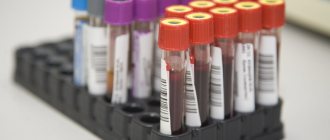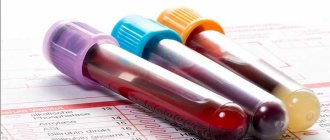If the antithrombin test result is low
This may indicate the presence of a disease or malfunction of body systems. But not only! This indicator, for example, is typical when taking oral contraceptives, as well as in the middle of the menstrual cycle.
For what diseases will the test result be low?
- atherosclerosis, in which plaques form on the walls of blood vessels;
- inflammation due to infection (sepsis);
- hepatitis and other liver diseases;
- chronic lack of antithrombins in the body;
- thromboembolism (separation of a blood clot and subsequent blockage of the vessel).
Indications for the study
Antithrombin 3 is synthesized mainly in the upper layer of vascular walls and in the liver and, in combination with heparin, is one of the most powerful blood thinning factors.
Analysis for AT III is indicated in the following cases:
- if heparin is insufficiently effective;
- to determine the causes of thrombosis;
- before antigen test;
- for the diagnosis of autoimmune diseases (in particular systemic lupus erythematosus);
- after removal of the blood clot.
Norm of antithrombins during pregnancy
Varies depending on trimester. During this period, a woman’s hematopoietic system works differently; the functions responsible for clotting are activated. It is important to monitor the risks of blood clots, which can cause miscarriage problems, as well as complications during childbirth.
In the table of values we present the average data of a healthy pregnant woman, dividing them by week:
| Gestation period, weeks | Normal indicator, percentage |
| from 13th to -21st | from 74 to 115 |
| from 21st to 29th | from 73 to 114 |
| from 29th to 35th | from 76 to 112 |
| from 35th to 42nd | from 70 to 116 |
Antithrombin III
Stopping bleeding when blood vessels are damaged occurs due to the formation of clots, which consist of platelets circulating in the blood. A clot is formed with the assistance of a number of special enzymes - coagulation factors. In addition, under the influence of thrombin (coagulation factor II), fibrin is formed - a high-molecular protein that acts as a stabilizer of the formed clot, stopping bleeding.
Antithrombin III is a glycoprotein (protein) that is formed in the endothelium (the outer layer of the inner surface of blood vessels) and in the liver. It is the main internal direct (i.e. active, ready for immediate action) anticoagulant, whose task is to block the blood clotting process. This is achieved by forming a stable complex with thrombin, which deprives the enzyme of activity. In the same way, antithrombin III suppresses the activity of a number of other enzymes: VIIA, IXA, XA, XIA, XIIA, which avoids the formation of excess blood clots and maintains a balance between the action of the coagulation system and the anticoagulation system.
In its natural state, the process of thrombin inactivation occurs slowly, accelerating over time. The catalyst for the formation of irreversible complexes between thrombin and antithrombin III is another direct anticoagulant - heparin. However, a low level of ATIII neutralizes the anticoagulant effect of heparin.
With a deficiency of antithrombin III, the risk of thrombosis (formation of blood clots in blood vessels) and thromboembolism (acute blockage of a blood vessel by a thrombus) increases. Protein deficiency can be hereditary or acquired. There are two types of hereditary deficiency:
- Type I is characterized by the absolute absence of antithrombin III due to the absence of genes responsible for its production in the body;
- Type II is characterized by the synthesis of an abnormal protein with impaired functions, which causes a decrease in its overall activity.
Cases of hereditary deficiency of antithrombin III are quite rare - according to various sources, the frequency of the pathology is 1 in 2,000 - 5,000 cases. As a rule, deep vein thrombosis is a consequence of any type of hereditary antithrombin III deficiency. There are also known cases of the development of sudden repeated thrombosis of atypical vessels (intestinal veins, for example, or the brain). Another characteristic manifestation of hereditary protein deficiency is heart attacks and strokes at a young age. With hereditary protein deficiency, the maximum risk of blood clots occurs between the ages of 15 and 40 years. If there are concomitant factors (for example, pregnancy), the likelihood increases even more.
The most common causes of acquired antithrombin III deficiency are:
- impaired protein production by the liver (the causes of this disorder may be liver failure, cirrhosis of the liver, liver cancer, poor nutrition);
- loss of protein (usually due to nephrotic syndrome, as well as some other conditions);
- coagulopathies (conditions characterized by a violation of the blood clotting process, in particular, disseminated intravascular coagulation syndrome and microangiopathy (damage to small blood vessels) with thrombosis);
- massive thrombosis (for example, due to acute blockage of an artery).
In addition, protein levels may decrease due to:
- long-term use of heparin;
- the use of significant doses of oral contraceptives;
- blood loss;
- surgical operation;
- development of malignant neoplasms.
Regardless of the cause of antithrombin III deficiency, the most common signs of this condition are recurrent venous and arterial thrombosis.
Antithrombin in pregnant women: deviation from the norm
If the value has not increased by much, the doctor simply observes the situation and may need to repeat the study. And only if the level goes off scale, medications are used.
A serious deviation cannot be ignored. Changes can lead to deep vein thrombosis in the legs, intrauterine fetal death, and miscarriages.
The level of antithrombin in pregnant women is monitored to prevent it from reaching a critically low level, which is dangerous for the life of the mother and fetus. Although a slight decrease, especially by the third trimester, is normal.
Preparing for antithrombin III testing
To ensure the reliability of the result, you must follow the following rules for preparing for the study:
- Blood is taken for analysis on an empty stomach - the last meal should be 12 hours before the test. For children this period of time will be shorter and depends on age;
- before the study, you should exclude physical activity and stress (at least 30 minutes);
- It is not recommended to smoke for half an hour before donating blood for analysis.
Venous blood is used for analysis.
Detailed description of the study
During bleeding, platelets circulating in the blood plasma, with the participation of many clotting factors, form a clot. Along with this, under the influence of thrombin, the fibrin protein is formed, which stabilizes the formed blood clot, after which the bleeding stops.
Antithrombin III is a protein that regulates blood clotting. This protein prevents the formation of blood clots, which is necessary to maintain balance between the coagulation and anticoagulation systems. To this end, antithrombin III binds to enzymes called serine proteases, as well as thrombin, factor IXa and Xa, and inhibits their activity. Sufficient amounts of clotting factors and antithrombin III allow bleeding to be stopped without excessive clot formation.
Antithrombin III deficiency is associated with an increased risk of thrombosis and thromboembolism. It may be hereditary or acquired. According to various estimates, the prevalence of hereditary antithrombin III deficiency ranges from 1 in 2000 to 1 in 5000 cases.
Hereditary antithrombin deficiency is divided into type I and type II. Type I leads to the complete absence of this protein in the blood due to the absence of genes that ensure normal synthesis of antithrombin III. Type II deficiency is characterized by the production of altered protein, which impairs its function. The overall activity of antithrombin III decreases.
Lack of production or incomplete activity of antithrombin III most often manifests itself in the form of deep vein thrombosis. However, there is a risk of repeated sudden thrombosis of atypical vessels, for example, veins of the brain or intestines. The first occurrence of thrombosis occurs at a relatively young age, with the risk of blood clots peaking between the ages of 15 and 40 years. This is especially important against the background of concomitant factors that increase the risk of thrombosis, for example, during pregnancy.
Acquired deficiency of antithrombin III is usually associated with either a decrease in its production in the liver in the case of liver failure, cirrhosis, malnutrition, or with loss of protein by the body in nephrotic syndrome and some other conditions. A decrease in the concentration of antithrombin III is observed in coagulopathies, including disseminated intravascular coagulation syndrome, microangiopathy with thrombosis. In many malignant neoplasms, its production is also disrupted. The use of the anticoagulant heparin significantly increases the activity of antithrombin III, which makes it possible to prevent thrombosis.
The influence of antithrombin III on the body is extensive, so determining the level of this indicator in the blood allows you to avoid the negative consequences of its deficiency and select treatment.
Description
The site of antithrombin III synthesis is the liver and the inner wall of blood vessels or the endothelium. By structure, it is a two-component protein found in plasma. The formed elements or blood cells do not stick together thanks to this substance so that the blood remains liquid. This is the primary coagulation factor, which is constantly present in the blood and controls its fluid state, its level does not depend on whether clot formation is currently required or not.
If a blood vessel is damaged, a coagulation cascade or sequence of biochemical reactions is activated, leading to the closure of the wound by a thrombus and stopping the bleeding...
AT III controls this process; at its “command,” the formation of a blood clot stops. The clot that is formed is exactly what is required to block the wound lumen - no more and no less. AT III irreversibly binds the main protein that forms clots - thrombin. Thrombin forms a framework on which the clot collects. Without this framework, thrombus synthesis is impossible.
Self-binding occurs slowly and increases gradually. If you add heparin, the binding of thrombin accelerates significantly. Therefore, AT III has a different name - a cofactor or “accelerator” of heparin. Antithrombin III consists of two functional parts - one part irreversibly binds heparin, the other inhibits it or restrains it.
If the AT III level is low, then the person is at risk of thrombosis. Antithrombin III deficiency can be congenital or acquired. In the congenital form, thrombosis occurs already at the age of 20-30 years, which causes heart attacks and strokes.
More often, deficiency of this substance is acquired; there are two forms. In one case, AT III has a normal structure, but its amount is insufficient. In the other, the quantity is normal, but the structure is defective, which is why the substance cannot perform its function.
This indicator is used to judge the capabilities and resources of the blood anticoagulation system; it is an obligatory component of the coagulogram.
The main manifestation of AT III deficiency is thrombosis that occurs in the arteries and veins of various organs. An elevated level of this indicator indicates a risk of bleeding.
In pregnant women, the coagulation system works intensively; their normal values differ from those of healthy people.
Read completely
Antithrombin III - 400 rub.
Urgent analysis - 800 rub.
Deadlines
Normal – 1 day.
Urgent – 1.5 – 2 hours.
Taking blood from a vein is paid separately - 300 rubles.
(If several tests are performed simultaneously, the service for collecting biomaterial is paid once)
Indications
- selection of treatment for the prevention of thrombosis in bedridden patients
- preparation for surgery
- pregnancy and preparation for childbirth
- injuries of various organs
- venous thrombosis
- control of anticoagulant treatment
- abnormal menstrual bleeding
- acute phase of viral hepatitis
- vitamin K deficiency
Material for analysis
Blood plasma (citrate). The material must be delivered to the laboratory within 2 hours from the moment of blood collection or frozen at a temperature of -20 degrees C
Preparing for the study
The material is venous blood, which is taken in the morning on an empty stomach after a night break in food from 8 to 14 hours. The day before blood sampling, you should not overexert yourself physically or drink alcohol. Drinking water is not limited. In urgent cases, blood sampling is allowed 4 hours after eating.
Complexes with this research
Coagulogram Study of the functional state of hemostasis 1,390 R Composition
Miscarriage Identification of the main causes of miscarriage 31,040 R Composition
Female infertility Analysis of women's reproductive health 10,650 RUR Composition
IN OTHER COMPLEXES
- Examination during pregnancy. 1st trimester 11,430 RUR
- Pregnancy planning. Clinical indicators 4,350 R
- Extended coagulogram 3,000 R
- Examination during pregnancy. 3rd trimester 6,310 RUR
- Entry into IVF RUB 16,590







